SBI PO level or other reasoning puzzles can now be solved quickly but you need to be careful
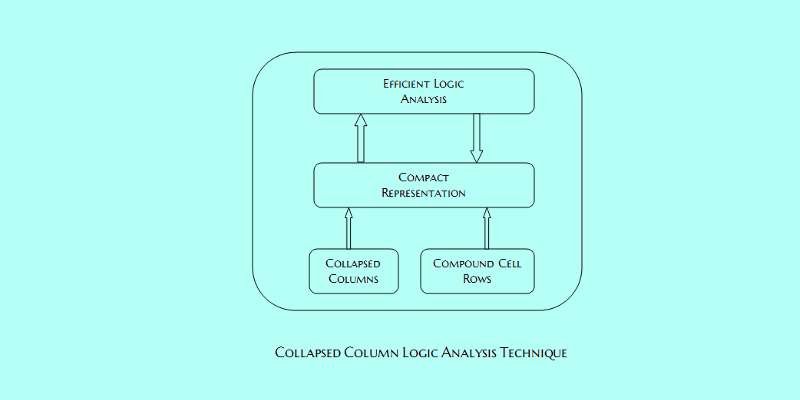
We have discussed logic analysis in our earlier sessions on Simple logic analysis and Complex logic analysis and efficient method of collapsed column logic analysis technique for solving SBI PO or higher level logic puzzles in our previous session on How to solve SBI PO level logic puzzles in a few simple steps 1. In this session we will consolidate and expose the powerful method further through solving a second SBI PO level puzzle.
Before going through this session, clear understanding of the concepts explained in the first session on efficient solution process for logic puzzles is strongly recommended.
Warning:
The collapsed column logic analysis technique may seem to be easy and attractive for solving logic puzzles of any difficulty level efficiently in quick time. But these problems are inherently confusing and potentially a mine-field of errors.
Unless the problem solver
- understands the nature and structural variation of this problem class,
- absorbs the efficient collapsed column technique with sufficient clarity and
- builds up confidence through the essential activity of solving many such problems of different structures,
attempting such a tricky logic puzzle in actual test environment is not recommended. There is nothing wrong with the method, but large puzzles being inherently complex and confusing, chances of losing your way wasting critically valuable time will be high.
We will take up an SBI PO level logic puzzle now and solve it efficiently using Collapsed column logic analysis technique that simplifies the solution process and reduces the time to solve considerably.
Assignment logic analysis using Collapsed column logic analysis technique
In Assignment logic analysis problems there is a set of objects that are to be assigned (or mapped) to a second set of objects determined by a set of logic statements or conditions.
The objects that are to be assigned belong to the to-be-assigned object set (TBA object set) and the objects to which the to-be-assigned objects are to be assigned belong to the to-be-assigned-to object set (or TBAT object set). In case of one-to-one unique assignment between two object sets, any of the two object sets are interchangeable with the other with respect to assignment as assignment is a mutual two directional operation.
Usually this type of logic puzzles seem to be quite confusing but using collapsed column logic analysis technique it is possible to solve any problem of this class in a structured and efficient manner.
In the simplest form of assignment logic puzzle, one set of objects are to be assigned to a second set of objects according to a third set of given conditions. The conventional method to solve this form of problems is to represent the values of the two object sets, one as rows and the second as columns. This representation is the simplest form of 2 dimensional logic table.
The cell values represent assignment between the members of the two sets. For example one set may be husbands and the second wives; problem will be to determine who is married to whom according to a set of conditions. The names of husbands may form row labels and names of wives column labels. Cross section of a row and column will represent marital status of the pair involved.
Difficulties in solving assignment logic analysis problems
There are two basic difficulties of this type of representation and analysis.
Firstly if the number of members of a set is large we have to deal with a large table. For example if there are 8 pairs of husbands and wives the logic table to determine who is whose husband will be a 8 by 8 table with 64 cells. For 10 pairs it will be 100 cells.
In collapsed column logic analysis technique the columns will be collapsed onto only a few. For example in the case of the problem of 10 pairs of husbands and wives, we may use the 10 wives' names as 10 row labels and only one column for final recording of the husband's name. The representation becoming very simple, analysis can also be carried out with much higher speed, accuracy and confidence.
But a higher level of difficulty arises when instead of two sets of objects there are 3 or more sets of objects in the assignment activity. In this case it is no longer possible to represent the logic states in a two dimensional logic table of one set of columns and one set of rows. To get over this problem, in collapsed column logic analysis technique one to-be-assigned-to object set is marked as primary TBAT set and its values form the rows. Instead of a single cell in the cross-section of a row and column the cross-section cells are converted to compound cells each consisting of more than one cell. The number of cells in a compound cell will be the number of rest of the object sets (excluding the row value set).
In well developed puzzles there may be more than one column for a row and the maximum number of columns will be determined by the maximum numbers of members that can be assigned to a row value.
The following is the conceptual representation of the solution process of such a complex logic puzzle using collapsed column logic analysis technique.
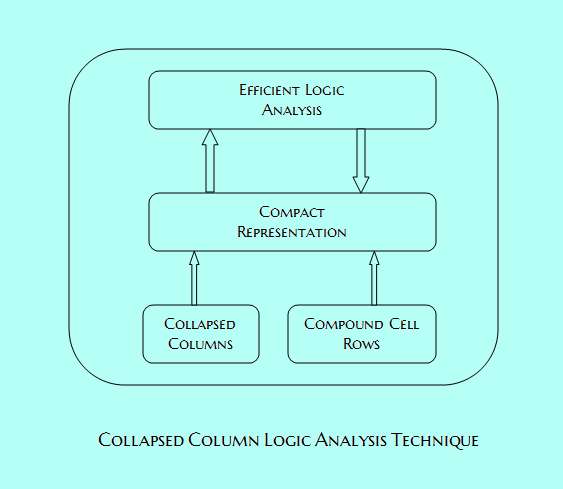
Problem example: Reasoning puzzle: Which employee in what department likes which sport
Problem description
A, B, C, D, E, F, G and H are employees in an organization belonging to three departments, namely Administration, Finance and Marketing such that not more than three employees work in the same department. Each of them has a different choice of sports namely, Badminton, Cricket, Football, Basketball, Hockey, Volleyball, Lawn tennis and Table tennis but not necessarily in the same order.
Conditional statements
- D works in Administration and does not like either football or cricket.
- F works in Finance with only A who likes table tennis
- E and H do not work in the same department as D.
- C likes hockey and does not work in Marketing.
- G does not work in Administration and does not like either cricket or badminton.
- One of those who work in Administration likes football.
- The one who likes volleyball works in Finance.
- None of those who work in Administration likes either badminton or lawn tennis.
- H does not like cricket.
Questions
Question 1. Which of the following groups of employees work in Administration?
- EGH
- AF
- BCD
- BGD
- Data insufficient
Question 2. Which of the following combinations of employee-department-favorite sport is correct?
- E-Adminstration-cricket
- F-Finance-lawn tennis
- H-Marketing-lawn tennis
- B-Administration-table tennis
- None of the above
Question 3. In which department does E work?
- Finance
- Marketing
- Administration
- Data insufficient
- None of the above
Question 4. What is E's favorite sport?
- Cricket
- Badminton
- Basketball
- Lawn tennis
- None of the above
Question 5. What is G's favorite sport?
- Cricket
- Badminton
- Basketball
- Lawn tennis
- None of the above
Problem example: Solution to the reasoning puzzle: Problem analysis
This problem belongs to the Assignment logic analysis class where there is one or more than one set of objects that are to be assigned to one or more than one set of objects. The assignments or mappings are determined by a set of conditional logic statements. If there are more than one set of to-be-assigned-to objects the set of fewest members is generally designated as the Primary to-be-assigned-to object set. For example, in this problem the employees form the single to-be-assigned object set whereas the sports and the departments form the two to-be-assigned-to object sets.
Out of the two to-be-assigned-to object sets departments form the primary to-be-assigned-to object set as it has fewest member values (only three members versus eight sports values).
The condition or logic statements determine the correct mapping.
The given problem thus falls under the second level of complexity with two to-be-assigned-to object sets and a total number of 3 object sets. It thus is a three-dimensional problem.
Solution objective and Strategies
Our main objective is not only to answer correctly but also to do it in as little time as possible adhering to Efficient Problem Solving philosophy.
Strategy 1.
As there are five questions covering the description of the problem comprehensively, we don’t have any other option than to complete the assignment fully and comprehensively.
If there were only one question, we could have tried to analyze the logic statements and fill up only a part of the logic table for reaching the goal.
Strategy 2 and 3.
The aspects on which we would cut-short the time to fill up the complete logic table will then be,
- An efficient representation of the three dimensional table, aiding understanding and filling quickly with least amount of writing (writing and spread of table increases time), and,
- An efficient sequence of analyzing (or processing) the condition or logic statements.
At the last level you need to be comfortable in elementary logic analysis because this skill you have to use for final assignment as well as determining the optimal sequence of processing logic conditions.
As you gather more experience, compact logic table representation will become easier and focus of attention will shift towards optimal logic condition sequencing and logic analysis skill at various levels.
Problem solving execution: Strategy 2 implementation: Compact representation
Out of three sets of objects involved in assignments, set of Employees forms the to-be-assigned objects, and sets of Sports and Departments form the two to-be-assigned-to object sets out of which we have already identified Departments as the primary to-be-assigned-to object set and these values will form the row labels.
In this method we won’t represent the problem solving data in a spread out logic table. Instead we will use a compact form which can be written on scratch paper quickly and understood and used for the next stage with ease and accuracy.
Thus as row label values we will select the three departments Administration, Finance, and Marketing. The other two sets, Sports and Employees will be placed in three columns. This is because of the given condition fragment, "not more than three employees in a department". So each Department may have a maximum of three employees, that is, each row may have a maximum of 3 columns (it may also be two columns). The breakup of employees will then be 3, 3 and 2. You see, the analysis has already started even at this early phase of problem representation.
Each row will be a combined complex one meaning, for each Department and each Employee column for the Department, there will be two cells, one for the employee name and the other for the sport name the employee likes. Thus instead of a single cell at the cross-section of a column and row there will be multiple cells. By this technique of representation we can handle problems of higher dimension also with ease.
The cells can hold specific assigned values or intermediate results, and ultimately only the specific assigned values when all assignments are over.
Now we will analyze and deal with the nine conditional statements.
Problem solving execution: Strategy 3 implementation
Step 1. We will process those logic statements first that directly make definitive assignment of a to-be-assigned object to a to-be-assigned-to object of primary set, in this case to Department. The statement with maximum degree (number of objects referred to) will be selected first.
In case of more than one such direct assignment statements of similar degree (information content by referral for example), we will select all such statements together to process at this first step to speed up the whole problem solving.
Only the first and second statements make a direct assignment to the primary to-be-assigned-to object set of departments. So we will apply these two statements in the first step.
After processing these two statements our logic table will look like,
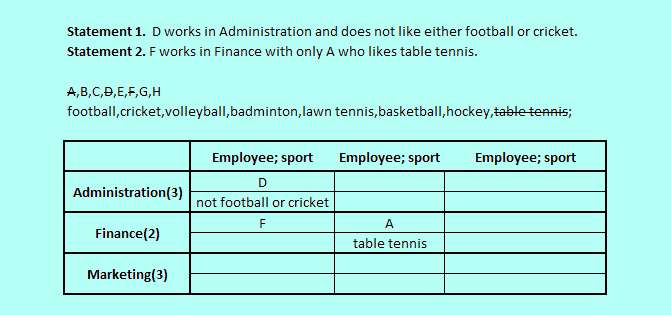
The information of D not liking football or cricket is noted in the second cell below the cell holding the employee name D for the row Administration. This is the compound cell for the Administration row consisting of two cells one below the other. The first represents employee name and the second in time will represent the sport the employee D working in Department Administration likes. At the moment we don't have enough information to assign a sport uniquely to D, but nevertheless we record the partial information about D's liking for a sport.
The second statement makes it clear that Finance is the lone two employee department with employees F and A who also likes table tennis that we record in the cell below A. As we already know the employee distribution to be 3, 3, 2, the other two departments could be identified as the three employee departments. The number of employees in a department is noted under a bracket against the department concerned.
Before taking the next step we cross out employee names D, F and A and the single sport name table tennis from the corresponding lists.
Step 2. At this stage, with no other statement making a direct assignment of an employee to a department we process the next two statements 3 and 4 serially.
After processing these two statements our logic table will look like,
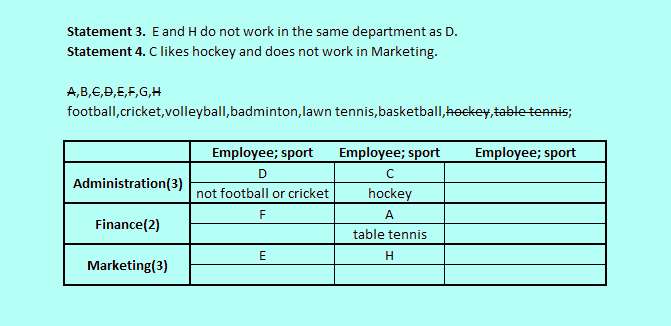
As department Finance is already filled up and the two employees F and A, and by the third statement E and H do not work with D, we can assign these two directly to the remaining department Marketing. This is what we call simple or elementary logic analysis where even though there was no direct assignment, together with existing condition, use of 3rd statement could assign the two employees to their assigned department.
And this is why we have selected statement 3. It is an indirect but certain assigniment statement that results in certain asignment by logic analysis based on the statement condition together with the status of the logic table. The other reason for choosing statement 3 has been its reference to as many as three employees, the maximum. The more the number of references, the more potential the statement will have for achieving certain assignment.
Next we have chosen 4th statement because after processing of the 3rd statement, we could see that the 4th statement employee C can be assigned to a department with certainty.
By the 4th statement C is directly assigned to Administration and its favorite sport could also be assigned. The corresponding object values are crossed out from the two lists at the top of the logic table.
Step 3. By the same logic as before we will process the next two statements 5 and 6 serially.
After applying these two statements the logic table will have the state,
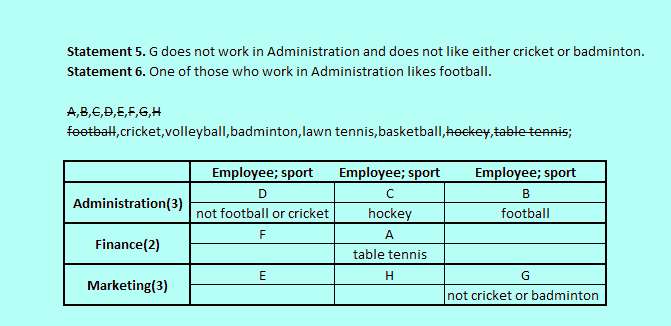
In this third step we could assign G and its favorite sport information against the third empty slot of department Marketing. This again is an example of indirect but certain assignment.
In fact, after the first step of processing the direct and certain assignment statements, all subsequent certain assignments will be indirect. These indirect certain assignments will be achieved by matching or analyzing the suitable remaining statements with the current information in the logic table. As you can perceive, the more certain assigment you achieve by selecting the right statement, the faster you will reach the final stage.
Now only one employee slot is left in Department Administration and the employee left to be assigned is B. This is an example of certain assignment by exclusion. B is the only employee left with only one slot in Administration left for her.
At this point with the 6th statement we know that B likes football. The assignments and the crossing out of values are done to complete the third step. This shows the importance of noting all information, even if it is partial, while you process a statement. Knowing that D does not like footbal, we could be certain that it is B who satisfies both the conditions in statement 6.
Step 4. In the 4th step we select only one statement 7 to show the effect of the last two statements clearly in the last step 5.
After this step the logic table looks like,
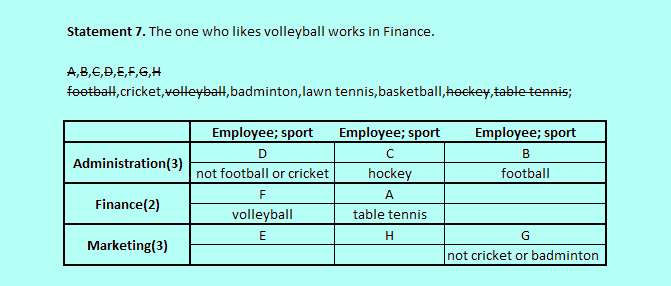
By applying statement 7 we simply get volleyball assigned to employee F.
Step 5. In this last step we have only two statements 8 and 9 left which will be processed together. The final logic table now is,
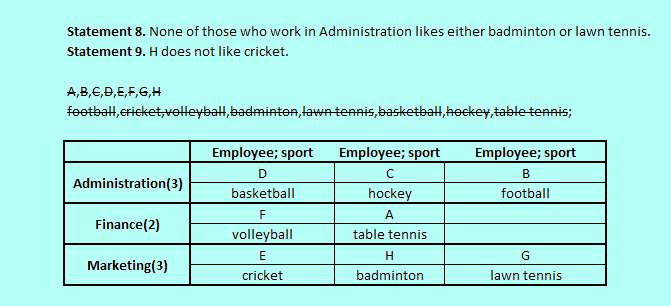
At this stage we will do a bit of elementary logic analysis.
Just before this last step we had four sports cricket, badminton, lawn tennis, and basketball yet to be assigned and only employee D to be assigned a sport with certainty in Administration. Thus by applying statement 8 we find that D is the employee referred to and its sport is not badminton or lawn tennis. As D already does not like cricket, the remaining fourth sport basketball must be the sport D likes. Note that, once football has been assgined to B earlier, the information of D not liking football has become redundant and unimportant.
Now three sports cricket, badminton and lawn tennis are left to be assigned.
Again in continuation to this chain of logic we find that employee G does not like cricket or badminton. So lawn tennis must be the sport G likes leaving only two sports cricket and badminton left.
By statement 9 employee H does not like cricket and so H must be liking badminton with the last sport cricket going to E and the assignments are complete.
The last bit of elementary ogic analysis could be done because of already recorded partial sport information against the employees.
Now we are ready to answer the questions and it should take only about a minute's time to answer the five questions.
Answers
Question 1. Which of the following groups of employees work in Administration?
Answer 1. Option 3: BCD.
Question 2. Which of the following combinations of employee-department-favorite sport is correct?
Answer 2. Option 5: None of the above.
Question 3. In which department does E work?
Answer 3. Option 2: Marketing.
Question 4. What is E's favorite sport?
Answer 4. Option 1: Cricket.
Question 5. What is G's favorite sport?
Answer 5. Option 4: Lawn tennis.
Note that the question 2 is a bit problematic as it involved three object sets. For quick elimination validity of a pair of values for each choice set should be tested. After all the first four choices are exhausted one may feel a bit perplexed, but nothing to worry as the fifth choice value is given only for this situation. Sometimes this negative choice value is the correct answer. With unshakeable faith on the final assignment table there should not be any scope of error.
Important to note
In practice you won’t write all the logic table states separately that we have done for detailed explanation. You will reach the final table at one place, only modifying the assignments at each step. As the process above is a step by step clear method, if you can quickly analyze the statements and follow the method systematically, you will reach the final state of the logic table quickly, correctly and assuredly.
After forming the final logic table, answering the five questions should take about only a minute more.
Secondly, in actual tests the condition statements are not usually given separately marked like we showed. Instead these are mixed up in a running paragraph as below,
D works in Administration and does not like either football or cricket. F works in Finance with only A who likes table tennis. E and H do not work in the same department as D. C likes hockey and does not work in Marketing. G does not work in Administration and does not like either cricket or badminton. One of those who work in Administration likes football. The one who likes volleyball works in Finance.
While solving the problem, the conditional statements must be individually marked and analyzed for a structured efficient analysis.
Recommendation
The collapsed column logic analysis technique is a structured, systematic, clear, and efficient framework for analyzing logic puzzles of any complexity with ease, speed and confidence without being confused. But one must be thoroughly conversant with variations of this class of problems as well as solving the puzzles using this efficient method. Without solving a lot many logic puzzles during timed practice sessions one should not attempt a tricky logic puzzle question in an important competitive test.
End note
Solving reasoning puzzles does not need knowledge on any subject—it is just identifying useful patterns by analysis of the problem and using appropriate methods. It improves problem solving skill, because patterns and methods lie at the heart of any problem solving.
Other resources for learning how to discover useful patterns and solve logic analysis problems
Einstein's puzzle or Einstein's riddle
The puzzle popularly known as Einstein's puzzle or Einstein's riddle is a six object set assignment logic analysis problem. Going through the problem and its efficient solution using collapsed column logic analysis technique in the session Method based solution of Einstein's logic analysis puzzle whose fish should be a good learning experience.
Playing Sudoku
As a powerful method of enhancing useful pattern identification and logic analysis skill, play Sudoku in a controlled manner. But beware, this great learning game, popularly called Rubik's Cube of 21st Century, is addictive.
To learn how to play Sudoku, you may refer to our Sudoku pages starting from the very beginning and proceeding to hard level games.
Reading list on SBI PO and Other Bank PO level Reasoning puzzles
Tutorials
How to solve SBI PO level logic puzzles in a few simple steps 1
How to solve SBI PO level logic puzzles in a few simple steps 2
How to solve SBI PO level family relation problems in a few simple steps 3
How to solve SBI PO level floor stay Reasoning Puzzle in a few confident steps 4
How to solve high level circular seating reasoning puzzles for SBI PO in confident steps 5
How to solve high level hard two row seating reasoning puzzles for SBI PO in confident steps 6
How to solve high level circular seating arrangement reasoning puzzles for SBI PO quickly 7
How to solve high level nine position circular seating easoning puzzles for SBI PO quickly 8
How to solve high level box positioning reasoning puzzle for SBI PO quickly 9
Solved reasoning puzzles SBI PO type
SBI PO type high level floor stay reasoning puzzle solved in a few confident steps 1
SBI PO type high level reasoning puzzle solved in a few confident steps 2
SBI PO type high level reasoning puzzle solved in a few confident steps 3
SBI PO type high level circular seating reasoning puzzle solved in confident steps 4
SBI PO type high level hard reasoning puzzle solved in confident steps 5
SBI PO type high level one to many valued group based reasoning puzzle solved in confident steps 6
SBI PO type high level hard two in one circular seating reasoning puzzle solved in confident steps 7
SBI PO type hard facing away circular seating reasoning puzzle solved in confident steps 8
SBI PO type high level four dimensional reasoning puzzle solved in confident steps 9
SBI PO type hard two row seating reasoning puzzle solved in confident steps 10
SBI PO type high level floor stay reasoning puzzle solved in confident steps 11
Solved reasoning puzzles Bank PO type
Bank PO type two row hybrid reasoning puzzle solved in confident steps 1
Bank PO type four variable basic assignment reasoning puzzle solved in a few steps 2
Bank PO type basic floor based reasoning puzzle solved in a few steps 3
Bank PO type high level floor stay reasoning puzzle solved in quick steps 4
